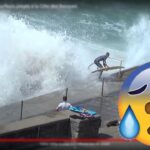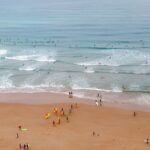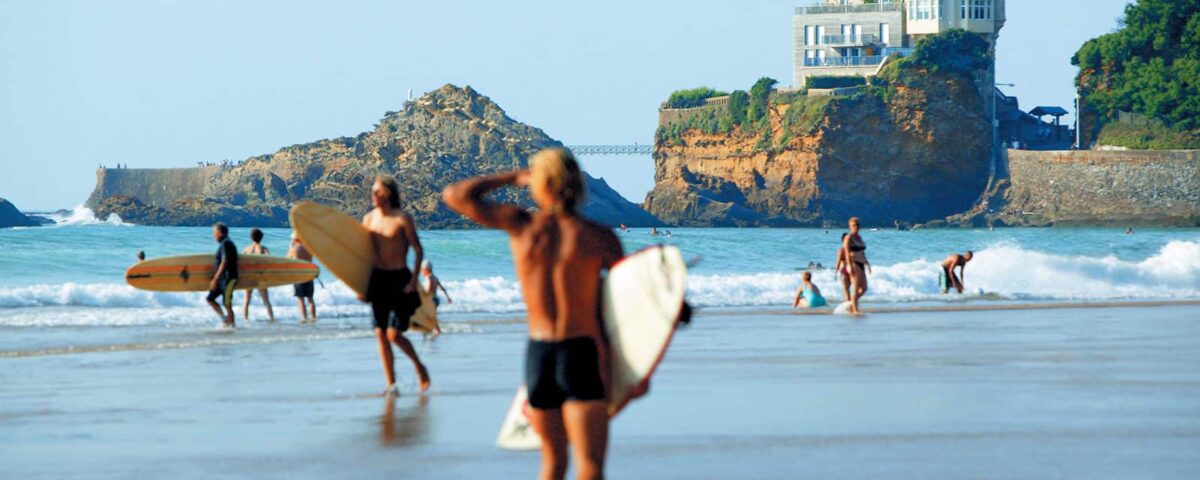
Surfing in Biarritz: all the dangers to avoid!

Where to learn to surf in Biarritz ? Best Spots and Conditions Explained
From the 1950s to the present day, the Côte des Basques beach is a magnificent strip of sand that stretches along the rocky coast of Biarritz. It’s a popular surf spot, known for its long, slow waves, ideal for longboards. However, at high tide, the beach can disappear completely, leaving only the rocks, which can make getting out of the water difficult: see article on the dangers of surfing.
Because of its surfing conditions and its role in the history of surfing, the Côte des Basques beach has become an iconic part of surfing culture. The Côte des Basques also offers spectacular views of the Basque coast, with the city of Biarritz in the background and the peak of La Rhune on the horizon. It’s a great place to relax, soak up the sun and watch the surfers catch the waves. The Côte des Basques district, facing the Atlantic Ocean, is famous for its beaches lined with surf schools and shops. The wave-shaped Cité de l’Océan interactive museum shows family films and houses a replica of a polar base. The cliff-top avenue Notre Dame is famous for its sunset views. At night, the panoramic terraces of the night bars attract crowds, as do the friendly restaurants serving burgers and beer facing the beach.
Contenus de la page
From Hawaii to the Côte des Basques
Although surfing originated in Hawaii, it made its way to Europe in the early 20th century. The first record of surfing in Europe was in 1926, when Prince Edward, eldest son of King George V of the United Kingdom, was photographed surfing in Waikiki, Hawaii. It was after this trip that he is said to have introduced the sport to Europe.
But it was in the 1950s that surfing really began to take off in Europe, particularly in Biarritz, France. Biarritz earned the nickname ‘the surfing Mecca of Europe’ thanks to the enthusiasm and commitment of a few key individuals. (See article in Sud Ouest) In particular, it is the Côte des Basques beach in Biarritz that is often cited as the cradle of surfing in Europe. In 1956, the American writer and scriptwriter Peter Viertel was in France shooting a film and brought with him some surfboards from California. He was photographed surfing the waves of the Côte des Basques, sparking great interest in the sport among the locals.
The “Tontons Surfeurs”
This is the nickname given to the pioneers of surfing in France, particularly in the Biarritz region. This group of surfers is credited with popularising the sport in the country in the 1950s and 1960s. Emblematic figures of surfing in Biarritz and France in the 50s and 60s include Joël de Rosnay, Michel Barland, Georges Hennebutte, and the brothers Robert and Jo Moraïz, among others.
They stood out from the other surfers because Joël is a scientist, who taught at the prestigious MIT, futurist, lecturer and writer. His wild brother, an adventurer and worldly seducer, added to the legend until, at the age of 38, he disappeared at sea in the Taiwan Strait while windsurfing (see Olivier Bonnefon’s documentary). Jo Moraiz, who founded France’s first surf shop and surf school , Michel Barland, became a shaper and went on to create surfboards with another entrepreneur, Jacky Rott. A company that continues the tradition to this day. Georges Hennebutte created the famous ‘ leash’ that connects surfers to their boards. Today, it’s only possible to bump into Mr Durcudoy, who at the age of 87 continues to admire the young surfers. He is the oldest surfer in France.
“For me, the story really began in September 1956, with the American film-maker Peter Viertel,” he says. That year, Viertel came to Biarritz to shoot “The Sun Also Rises”. He discovered the waves of the Côte des Basques, and brought a surfer from California. “I remember his line, which was the trigger for my whole surfing life: Do you want to see a man walk on the waves?” When Viertel went back across the Atlantic, he left his board with Georges Hennebutte. “My uncle and I surfed every day until December. I was 22, he was 47” cf. article in La depeche
Bars and restaurants on the côte des basques
- Le Surfing: A popular restaurant located near the beach, offering breathtaking views of the Côte des Basques.
- Bar Carlos: Another iconic establishment located near the Basque Coast.
- Etxola bibi en haut des cents marches: A simple open-air restaurant-bar with ocean views, offering salads, pokés bowls and cocktails.
Voir cette publication sur Instagram
Surf festivals
Biarritz regularly hosts surfing events and competitions involving the Côte des Basques.- Biarritz Quiksilver Maïder Arosteguy: One of the oldest surfing competitions in Europe, held every year over the Easter weekend.
- Biarritz Surf Festival: This event takes place every summer and includes surfing competitions, demonstrations, exhibitions and concerts.
- Wheels and Waves: An annual event that brings together motorbike and surf enthusiasts. It includes surfing and skateboarding demonstrations, motorbike exhibitions, concerts and more.
- Longboard competitions: The Basque Coast is known for its excellent longboard conditions, and several competitions are organised throughout the year.
The Maison du Surf and Julien Roulland are in charge of exhibitions and events.
Hotels and accommodation nearby
Facing the ocean, the CARLINA LODGE, located on the beach of the Côte des Basques, on the first two levels of the SUNSET Residence, with 19 hotel rooms and 5 flats, enjoys one of the most beautiful views of the Basque Coast in one of France’s most prestigious resorts. Villa Hélianthe, the building overlooking the beach, sometimes offers airBnB accommodation. We like to offer aparthotels with swimming pool and sea view, the best value for money in Biarritz.
How to get there
Car and bus access to the Côte des Basques
You can drive around and drop off your children and wife at the drop-off point just in front of the beach.
If you don’t want to take advantage of a superb pedestrian walk, you can use Biarritz’s free shuttle buses.
By car: The Côte des Basques car park and the Port Vieux car park are nearby .
By bus: You will be dropped off at the top of the côte des basques.
Access by free shuttle buses N10/ N11
Map and timetable of the free Biarritz city shuttles
the Côte des Basques shuttle
– Saturdays, Sundays and public holidays until 1 July – 7 days a week from 3 July to 3 September – Saturdays, Sundays and public holidays from 9 to 24 September Every 15 minutes from 10.00 to 20.00the City Centre shuttle
– Monday to Saturday (except bank holidays) until 1 July – 7 days a week from 3 July to 3 September – Monday to Saturday (except bank holidays) from 4 September Every 15 minutes from 7.30 am to 7.30 pm (20 minutes between 12 noon and 2 pm)the Saint-Charles/Milady/Cité de l’Océan shuttle bus
– Until 1 July and from 4 September Terminus Thermes Marins Monday to Saturday (except public holidays) every 20 minutes from 7.30am to 7.30pm (40 minutes between 12.30pm and 2pm) – Monday to Saturday (except public holidays) from 3 July to 2 September Terminus Cité de l’Océan every 25 minutes from 7.30am to 7.30pm (40 minutes between 12.30pm and 2pm)the Iraty shuttle
-7 days a week from 3 July to 3 September Every 15 minutes from 8.45 a.m. to 11.00 p.m.Emblematic buildings and monuments
Villa Belza is located on the cliff overlooking the Côte des Basques beach in Biarritz. Built between 1880 and 1895 by the architect Gustave Huguenin for the businessman Jules Pams, it is known for its neo-Gothic style and privileged location offering uninterrupted views of the Atlantic Ocean. The villa is sometimes called ‘the black castle’ because of its distinctive colour.
The Sunset: this building, which houses Carlos bars and restaurants and Surfing, also serves to support the cliff. A fine technical achievement in 70s architecture. Château d’Ilbarritz: Although situated a little further south, this emblematic castle can be seen from the beach.
Where was surfing born?
The first traces of surfing in Hawaii date back to 1769. During James Cook’s first voyage aboard HMS Endeavour, botanist Joseph Banks was the first to write about surfing in Tahiti’s Matavay Bay. But the history of surfing really began in Hawaii, as the archipelago was the first to make the sport known. In the 15th century, surfing was a common practice among the people of the island of Hawaii.
Who invented the surfboard?
In 1778, the explorer James Cook dropped anchor in Kealakekua Bay, Sandwich Islands (Hawaii). There he saw natives riding the waves on long planks of wood. These, called Papa-he-nalu, are traditionally carved from the trunk of a tree.
How was surfing invented?
Surfing has been a common practice in the Hawaiian Islands since the 15th century. It allowed tribal chiefs who challenged the sea to prove their power and superiority. They surfed on large tables, called Papa-he-nalu. They were cut from the trunk of a tree in an ancient ritual.
What’s surfing country?
Australia is known as the country of surfers and even the continent of surfers, but on a per square kilometre basis, there are more surfers in Switzerland than in Australia.





Surf lessons and Surfcamps gift voucher
Read more